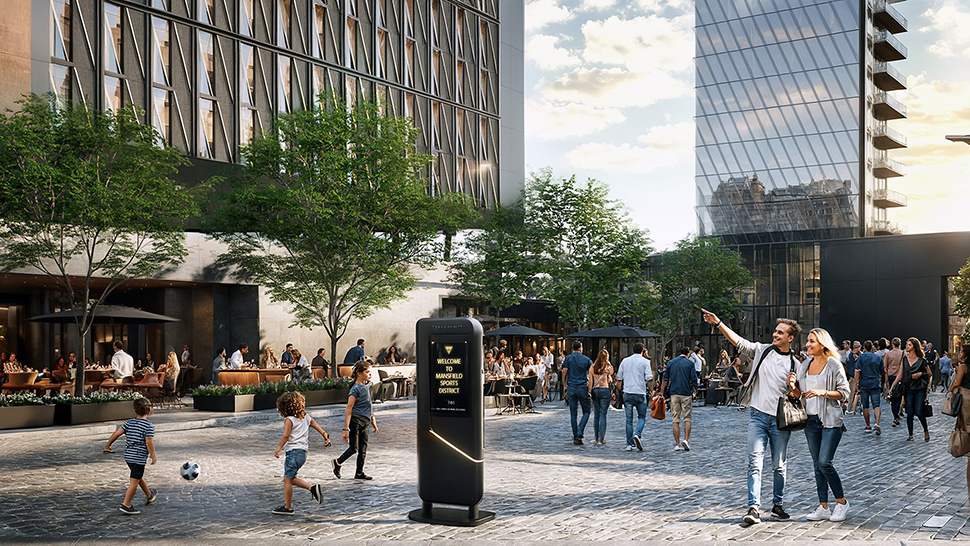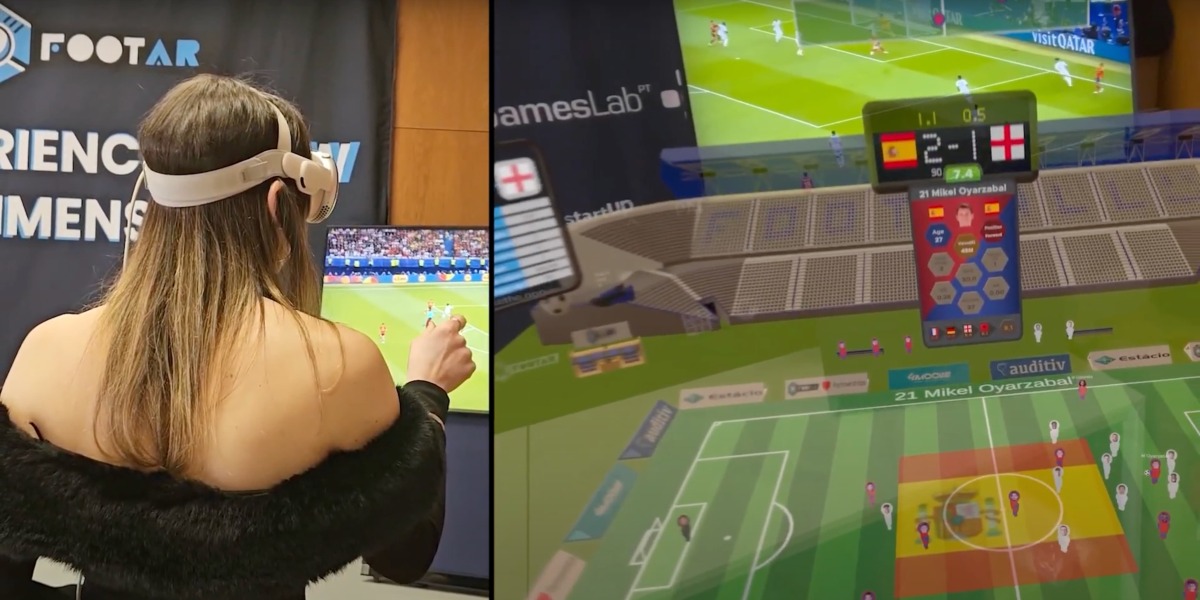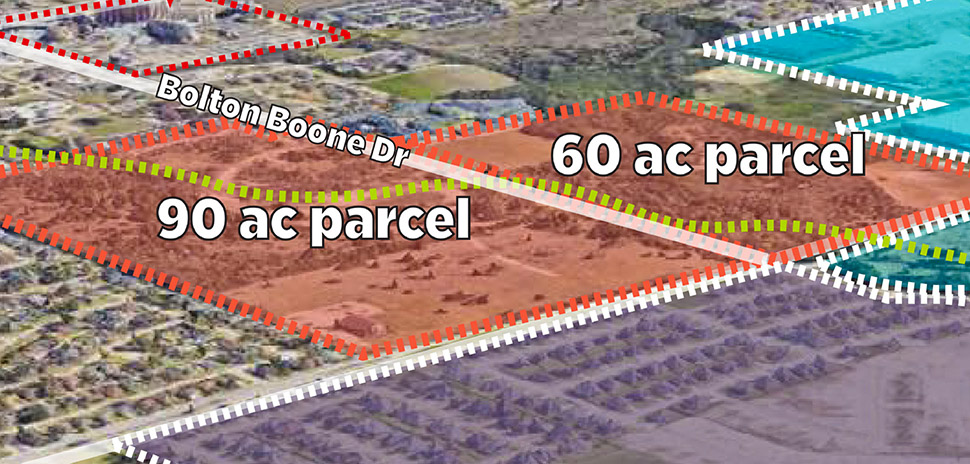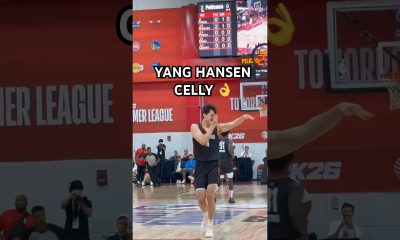Forget traditional mixed-use. Dallas-based House of Tangram is bringing something different to its 30-acre footprint inside Mansfield’s $2.5 billion Staybolt Street District: a sports- and wellness-anchored live, stay, and play ecosystem.
“We’re building a live-operating system for modern life—hotels with AI in their walls, convention centers reimagined, and retail that moves like culture,” said Shawn Ellis, founder and CEO of House of Tangram, in an announcement last week. “Think adaptive storefronts, curated activations, and brand-first experiences.”

Walkable public spaces in Mansfield’s sports district aim to connect hotels, residences, and immersive retail into one tech-integrated experience. Tangram’s goal: to build a “live-operating system for modern life.” [Rendering: House of Tangram]
At the center of that vision: three new hotels with personalized, AI-powered guest experiences, with technology driven by NuStudio.AI, a Dallas-based startup founded in 2023.
Co-founded by Krishna Nimmagadda, who also serves as House of Tangram’s Chief Technology and Strategy Officer, NuStudio’s platform uses an agentic AI model to help hotel environments adapt to each guest, down to the lighting, climate, and sleep settings.
“This project puts Mansfield on the national map,” said Nimmagadda, who co-founded and exited two AI companies before investing in North Texas land.
The hotels are just one part of the buildout. Tangram’s plan also includes two residential communities, over 100,000 square feet of retail and restaurant space, and a city-owned convention center designed for esports, medtech, and “high-performance” events.
“Staybolt Street isn’t just an entertainment and sports development—it’s a new operating system for the modern traveler, athlete, traveling professional, and event guest,” said Ellis. “From Carbon to Cache, we’re building highly intentional, category-defining experiences curated for the specific demographic.”
Construction is slated to begin in the summer of 2026, with completion targeted for mid-2028.
Let’s break it down.
The hotel trio
The hotel brands—Carbon, Cache Legitimate, and KUBO—launched under the House of Tangram flag, are designed with specific audiences in mind. Carbon Mansfield is built for traveling athletes and competitive teams. Cache Legitimate and KUBO cater to esports fans, digital nomads, and “creators on the move.”
Ellis says the brand’s hospitality vision is to redefine the travel experience and help the industry evolve.
“We’re building a tech-native hospitality system from the ground up,” said Nimmagadda, Partner, Chief Technology and Strategy Officer at House of Tangram. “These aren’t just smart hotels—they’re dynamic, programmable environments that personalize how people stay, recover, and connect.”
Across the properties, a custom-built tech stack connects guest identity to a responsive operating layer. According to the company, the system connects guest identity to a responsive tech layer that learns from each stay with biometric check-in and adaptive room controls to personalize future experiences.
“Our vision combines hospitality, entertainment, and smart design—anchored by a world-class convention center and immersive technology,” he said.
A hotel engineered for athletes: Carbon Mansfield

A rendering shows the Carbon hotel, powered by Dallas startup NuStudio.AI’s technology, adjacent to Mansfield Stadium, anchoring the southern edge of the entertainment district. [Rendering: House of Tangram]
The flagship property, Carbon Mansfield, will feature 288 rooms designed specifically for athletes and competitive teams. House of Tangram bills it as “the world’s first patented sports-centric hotel engineered for athletes and competitive teams.”
The description reads something like a high-performance lab in the guise of a hotel. The system, powered by NuStudio.AI, aims to optimize recovery times for traveling athletes.
The concept taps into a growing sports tourism market and aligns with a major investment rising right next door in the Staybolt District.
“Mansfield has always been known for sports and bringing a hotel concept that focuses on athletes next to our incoming Mansfield Stadium is a home run,” said Mansfield Mayor Michael Evans.
Mansfield is constructing a 166,000-square-foot multisport stadium, set to open in 2026 as the permanent home of North Texas SC, the MLS NEXT Pro affiliate of FC Dallas. The venue will also host elite youth tournaments, concerts, and regional events. It will be operated by REV Entertainment and FC Dallas Management, the stadium and soccer complex management affiliate of FC Dallas and a subsidiary of Hunt Sports Group.
Two programmable hotels designed for culture and creative flow: Cache Legitimate & KUBO
Next to Carbon, House of Tangram will debut a dual-branded hotel concept targeting esports fans, digital nomads, and creators.
“Cache runs on energy. KUBO runs on flow,” Ellis said. But both are built around guest experiences that adapt in real time. Picture robotic bartenders that know your drink preferences, drone delivery that anticipates your needs, and immersive media walls.
A convention center built to flex

A rendering of the Mansfield Convention Center shows digital art elements and programmable lighting integrated into the facility’s exterior design. [Rendering: House of Tangram]
House of Tangram will build and operate the city-owned, 33,000-plus-square-foot Mansfield Convention Center. Designed as a programmable space for esports, medtech, and high-performance events, it’s expected to attract a range of regional and national gatherings.
According to the developer, layouts can flex to accommodate stage setups, training sessions, and live demos. The convention center aims to complement the adjacent stadium and hotels, which could support coordinated planning across sports, hospitality, and tech-driven events.
Living, shopping, and playing inside the district’s connected ecosystem
The development includes two residential communities designed to extend the district’s responsive tech layer into everyday life. Mansfield City Manager Joe Smolinski said the district will be more than a hub for entertainment—it will be “the home for sport and athletes in the Metroplex.”
STEAM will offer 320 creative lofts with rooftop gardens, communal kitchens, and design features aimed at flexibility and community-building. Verona Gardens is set to add up to 400 wellness-first homes with features like hydroponics, pet studios, green roofs, and built-in climate intelligence.
Both communities are walkable to the stadium, retail, and convention center, and will connect into Tangram’s broader digital infrastructure.
Staybolt Street Retail is set to feature over 100,000 square feet of walkable storefronts curating “Texas-forward food, fashion, and cultural experiences,” the developer said.
On the entertainment front, the district also includes a multistory High 5 Entertainment venue with bowling, laser tag, virtual reality attractions, full-service restaurants, and a rooftop concert space.
The public-private play that brought it to life
House of Tangram, founded in 2020, calls the Mansfield project its largest development to date.
The developer secured its 30-acre footprint through a public-private partnership with Mansfield after what Ellis described as a collaborative process: “When the City of Mansfield reached out, we listened to what they needed and worked with the staff and council to curate what they asked for.”
The Staybolt Street Entertainment District as a whole is a 100-acre public-private partnership between the City of Mansfield and multiple development partners. At full buildout, it will include 750 hotel rooms, 700-plus multifamily units, a 166,000-square-foot stadium, 50,000 square feet of medical office space, and a wide mix of entertainment and retail.

An aerial perspective shows the full 100-acre Staybolt Street District vision, with hotels, residential, retail, and entertainment clustered around public plazas. [Rendering: House of Tangram]
With groundbreaking for House of Tangram’s portion of the district slated for next summer, Beck Group will serve as development manager and general contractor.
“The Mansfield project is bold in its scale and intentional in its design,” said Scott Lowe, chief revenue officer at The Beck Group, in the announcement. “It reflects how people live, travel, and perform today.”
Jason Moore, executive director of the Mansfield Economic Development Corporation, called the Tangram-led sport district development transformational: “We believe it elevates our regional identity, expands our hospitality and tourism economy, and creates a vibrant hub for commerce, entertainment, and innovation.”
That regional identity is already rooted in a deep sports and entertainment culture across North Texas. Arlington anchors the Dallas Cowboys and Texas Rangers, while Fort Worth draws crowds to Dickies Arena and Texas Motor Speedway. The Dallas Mavericks play at American Airlines Center, and nearby Grand Prairie is home to Major League Cricket. Beyond entertainment, D CEO magazine recently dubbed North Texas the Sport Business Capital of the World.
Mansfield’s Staybolt Street project adds a new layer to that ecosystem, extending the region’s sports and tourism economy into southern Tarrant County.
Mansfield on the grow
Located 29 miles south of DFW Airport, 20 miles southeast of Fort Worth, and 35 miles southwest of Dallas, Mansfield is ranked No. 27 on U.S. News’ 2025 Best Places to Live list. It’s a growing North Texas city positioning itself as more than a suburb.
“Staybolt Street will be a gamechanger for the Mansfield community,” Mayor Evans said when the district broke ground in August 2024. “For a long time, Mansfield has had a reputation as one of the best places to live, and now it’ll be known as an exceptional place to play.”
The city is also involved in several large-scale projects, including the $1 billion Canals at Mansfield—a mixed-use development within a larger $1 billion 210-acre urban mixed-use community called The Reserve—and the MIC Innovation District for technology companies and startups. Mouser Electronics, a global distributor of electronic components and semiconductors, also operates its headquarters in the city, employing more than 2,600 people locally.
The Mansfield mayor says the House of Tangram sports district project aligns with the city’s goals to focus on the future and develop a strong economy. “This partnership will make Staybolt Street Entertainment District the place to be,” Evans said.
Don’t miss what’s next. Subscribe to Dallas Innovates.
Track Dallas-Fort Worth’s business and innovation landscape with our curated news in your inbox Tuesday-Thursday.
R E A D N E X T
-
North Texas has plenty to see, hear, and watch. Here are our editors’ picks. Plus, you’ll find more selections to “save the date.”
-
UT Dallas researcher Dr. Walter Voit transformed Minecraft’s 170-million-player universe into an advanced virtual training ground—for students and for AI agents tested by DARPA. His team’s Polycraft World uses gameplay to turn classroom theory into real-world expertise, covering topics from synthetic organic chemistry to nuclear plants to semiconductor facilities. Their new startup company, Pedegree Studios, has licensed the core technologies from the university to create a scalable digital pipeline for education and workforce development.
-
Combining cutting-edge research and real-world applications, the UT Dallas professor transforms public health with innovations in detection technology, including “a check engine light” for the human body. In collaboration with EnLiSense, the company she cofounded, Dr. Prasad combines chemistry with software and hardware to bring the technology to life as market-ready devices.
-
The southern half of Dallas County is home to just over 1.05 million residents. That’s about 40% of the total number of people who call Dallas County home—and roughly 200,000 more than the entire population of San Francisco. Coupled with the fact that Dallas-Fort Worth is emerging as a top life science market, as documented in a 2023 CBRE report, you can see why the DeSoto Development Corp. is including an 80-acre Life Sciences Innovation Core among its major projects. “In terms of economic development, research shows that it’s more effective when it happens regionally,” says Matt Carlson, DDC’s chief…
-
Later this year, Netflix fans can go beyond streaming to full “entertainment immersion” at Netflix House in Galleria Dallas. Experiences will include “Stranger Things: Escape the Dark,” “Squid Game: Survive the Trials,” and a Netflix “RePLAY” game room.





































































